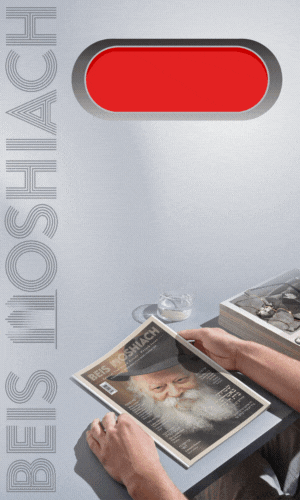An Oasis of Torah in the Pocono Mountains
Just a two-hour drive from Brooklyn, there is a yeshiva surrounded by forests, waterfalls, and brooks, forming a unique opportunity for learning and growth, free from the hustle-bustle of the city Beis Moshiach drove up to the Poconos to meet the staff and the students who make up a yeshiva that’s a family • Full Article
Avrohom Reinitz, Beis Moshiach
In every yeshiva there are bachurim who are more successful in their learning and those who are less successful; that’s normal. But when a bachur is transformed in yeshiva, and three years after entering he emerges a most successful bachur, that tells you something about the yeshiva.
That is the story of Y, a bachur without the strongest learning background. When he was accepted to shiur alef, he still was struggling somewhat with reading. After spending a Shabbos-yeshiva in Tomchei Tmimim in the Poconos, he believed that he would be successful here. The Chassidish homey atmosphere in the midst of nature, along with the warm personal attention of the staff, greatly appealed to him.
“This talmid became an outstanding lamdan,” the rosh yeshiva, Rabbi Menachem Mendel Eisenman told us. “The turning point was in the first year. The second year, he stayed in yeshiva for the summer to review the entire maseches Bava Basra and the third year, he was already considered the lamdan of the group, one who delves into a sugya well, and every reasoning that he offers is solid. When he raises a difficulty, we have to work hard to find an answer. Every question he poses is well constructed and thought out. He is a symbol and model of the uniqueness of our yeshiva.”
The yeshiva gedola in the Poconos opened five years ago as a continuation to the yeshiva in Queens. Director of the yeshivos, Rabbi Menachem Mendel Hendel, saw the need for a yeshiva gedola that would enable those who graduated from the mesivta (yeshiva ketana) in Queens to continue being educated in the spirit of Chassidishkeit permeated with faith and hiskashrus to the Rebbe MH”M.
One of the yeshiva’s founding principles was a letter from the Rebbe to Rabbi Shlomo Chaim Kesselman about the advantage of the yeshiva in the town of Lubavitch: “And several times I heard from my father-in-law, the Rebbe, about the matter of residence in large cities being difficult, and he extolled the advantage of the yeshiva in Lubavitch where the yeshiva was the main thing, and the rest of the matters of the town played no role in disturbing the students… as opposed to in New York, etc.”
The first year, the yeshiva was in Sea Gate in Brooklyn, which is one of the quietest neighborhoods in Brooklyn. A year later, the complex in the Poconos in Pennsylvania was purchased and the yeshiva moved there with the start of the 5775 school year.
In its second year, Rabbi Shmaryahu Matusof joined the staff as the lead mashpia. Until then, he was a teacher in the elementary school in Brunoy, France. The rosh yeshiva is Rabbi MM Eisenman, and for 5779, R’ MM Silman joined the staff as menahel ruchni and R’ Shmuel Newman joined as mashpia and maggid shiur for girsa. Each member of the staff is a special person and the combination of all of them together provides a power boost that translates into a unique impact on the talmidim of the yeshiva.
ORIGINAL APPROACHES TO LEARNING
R’ Eisenman, who is considered an outstanding lamdan in the world of yeshivos, has fresh methods in learning Gemara. This past year, the yeshiva incorporated the approach of learning aliba d’hilchasa (from Gemara to halacha) in which the focus is on those Rishonim and Acharonim that are directly connected to the halachic ruling. The entire process ultimately leads to the rulings of the Alter Rebbe in Shulchan Aruch with an emphasis on his chiddushim on the subject. After understanding the Alter Rebbe’s chiddushim, they go back to clarify the simple meaning of the Gemara, Rashi and Tosfos in light of the Alter Rebbe’s chiddushim.
R’ Eisenman began implementing this approach years ago, but last year the approach was intensified in light of the fact that the maseches being learned was Pesachim, where most of the sugyos are brought down, halacha l’maaseh, in the Alter Rebbe’s Shulchan Aruch. The aliba d’hilchasa was emphasized this year to the point that R’ Eisenman told the talmidim not to buy a Kovetz Meforshim, but a Tur Shulchan Aruch on Hilchos Pesach on which the learning focused, so as to better understand the Alter Rebbe’s chiddushim.
The sources that the rosh yeshiva posts every Sunday before the shiur klali also focus on Rishon and Acharonim that need to be learned in order to understand the Alter Rebbe’s approach.
This unique way of learning makes it possible to divide the talmidim according to level, thus enabling each one to bring out his potential. Every Sunday, the rosh yeshiva posts the weekly learning goals, divided into three tracks: the basic track includes Gemara, Rashi, Tosfos and the Alter Rebbe. The intermediate track includes commentaries like the Rosh, Ran and Tur Beis Yosef. The third track includes the Mechaber, Bayis Chadash, Turei Zahav, Magen Avrohom and Chok Yaakov on Hilchos Pesach (mentioned often in the Alter Rebbe’s Hilchos Pesach).
At the beginning of the year, the talmidim choose which track they prefer. Most of the bachurim try to challenge themselves with a track that is a bit beyond their current abilities, so they have what to strive for. After a few months, they can change tracks, but most of them remain in the track that they pick at the beginning of the year. This learning approach fits well with the personal attention that is provided.
Standard tests don’t always reflect a talmid’s knowledge. And who keeps a test after getting a mark? The alternative is the weekly summary that the talmidim write on Thursday. The summary has to fully cover one of the sugyos, from the Gemara all the way to the Alter Rebbe’s psak. These summaries are dear to the talmidim and they keep them.
“The approach to learning that we instituted,” says R’ Eisenman, “allows every bachur to find his place. One who is able to learn more in depth will find himself in the track with all the Rishonim. One who likes to focus on practical halacha, can feel at home in the basic track.”
PRACTICAL CHASSIDUS
In a conversation with R’ Matusof, he tells me that for many years, the Rebbe did not allow him to leave his chinuch job in France. In answers in the Igros Kodesh he was told to stay where he was. It was only after the yeshiva in the Poconos opened and he was offered a position as mashpia, that he opened to a clear answer from the Rebbe about his devoting himself to the talmidim in the yeshiva, with a bracha for success that the talmidim be tmimim deserving of that title.
After consulting with a mashpia, he moved to the Poconos. The move wasn’t easy and when, after two years, his wife wrote about the difficulties, the Rebbe answered her: you are in yeshiva two years already and are seeing success, so why are you writing that it’s hard? On the contrary, put in more!
As he tells it, “So too, after a year, I opened to a letter from the Rebbe which said he was happy with the development of the new yeshiva and when all members of the staff will invest more, also in the material matters, the yeshiva would grow in quality and quantity.”
When I speak with talmidim about R’ Matusof, they talk about him with great fondness. Aside from his astonishing encyclopedic knowledge of Chassidus and the ways of Chassidus, he has a special, unique style. In his farbrengens, he talks a lot about events from Tanach and with special skill he connects them to events in daily life and the tests of our generation. When he describes the period of the exodus, for example, the listeners feel like they are exploring the minds of the Jews who left Mitzrayim.
Aside from farbrengens, R’ Matusof gives weekly shiurim on Chassidic topics. He produces booklets on various topics in the life of tmimim as they are illuminated by sichos and maamarim and stories of Chassidim. These shiurim strengthen Lubavitch pride in the talmidim as well as emuna.
R’ Matusof and R’ Newman pick the maamarim to be learned in the evening seder so that they fit with the general approach of hiskashrus to the Rebbe. For example, last year, which marked 90 years since the Rebbe and Rebbetzin married, the yeshiva learned the Rebbe Rayatz’s maamarei chasuna with the Rebbe’s maamarim and explanations.
LIKE IN LUBAVITCH
While touring the yeshiva, one can’t help but be amazed by the wonders of nature. On one side of the campus there is a river which feeds into a gorgeous waterfall. On the other side is a dense woodlands with a powerful brook running through. Picture what it’s like to wake up in the morning and hear the crashing waters of the waterfall, or beyond that, to immerse in a cold brook and walk back through the woods. Nature is here in full glory and the air is crisp and intoxicating.
“One of the big problems of our generation is the inability to concentrate,” says the rosh yeshiva. “In order to thoroughly understand a daf Gemara, you need a high level of concentration. When you are in middle of the hubbub of the city, it is very hard to attain that focus. Here, in the Poconos, there are no disturbances and it’s easier to concentrate.”
The fact that the yeshiva’s staff lives on campus and are accessible 24 hours a day, contributes a lot to the homey atmosphere. Talmidim feel that staff members are willing to listen to them at any time, and the staff will often show up in the learning space even during off hours.
Occasionally, the bachurim are inspired and they go to the mashpia’s house and ask for a farbrengen. “There is a real feeling of closeness here,” says R’ Matusof. “The bachurim feel comfortable knocking at my door and asking for a farbrengen.”
Sometimes the knock is late at night and it’s one bachur at the door who needs help. The staff is always there for the talmidim, to listen and try and help. Speaking of personal conversations, when the weather makes it possible, the mashpia goes to the woods with the bachur and sits with him next to the waterfall and helps him work things out.
R’ Silman, the menahel, took the natural setting one step further and for Pesach, made wine with the talmidim. All the bachurim took part and, in the end, they each received a bottle of wine for the seder. “It consolidated us and helped the atmosphere of achdus tremendously,” he says.
“In addition to the special atmosphere thanks to the natural setting,” adds R’ Eisenman, “the hanhala of the yeshiva invests a lot into the gashmius and takes care of whatever the bachurim need. The living quarters are well-constructed, the beds are comfortable, and the dining room always serves tasty, nutritious food and in great quantities. There is no feeling of scarcity, on the contrary, there’s plenty and this helps a lot on the spiritual side of the learning. The talmidim have all the conditions for success!”
INFLUENCING THE ENVIRONMENT
Although the yeshiva is isolated, the bachurim illuminate their environment. It starts with the few Jews who live in the Pocono Mountains who are visited occasionally by the tmimim. There is outreach in nearby towns. Some travel two hours on Fridays to Philadelphia where there is a large Jewish community, and they do mivtza tefillin there.
The light of the yeshiva attracts people from the outside. In the summer, hundreds of religious Jews go on vacation on the campus near the yeshiva and many of them are exposed for the first time, from the inside, to a Chabad yeshiva.
For special days in the calenar, the yeshiva’s hanhala tries to bring a guest mashpia. Shluchim, rabbanim, and mashpiim who come to farbreng, leave with a feeling of open amazement by the Chassidishkeit of the bachurim and their chayus in inyanei Moshiach and Geula.
PERMEATED WITH MOSHIACH AND GEULA
In accordance with the sicha of the Rebbe at the Kinus HaShluchim 5752, that all matters of shlichus need to be permeated with the point of how does it lead to kabbolas pnei Moshiach, all of life at the yeshiva revolves around this point.
At farbrengens, mashpiim speak a lot about the need for avoda pnimis to be ready to greet Moshiach; on mivtzaim the bachurim publicize the Besuras HaGeula; after the learning sedarim there is a daily seder for learning inyanei Moshiach and Geula and once a week there is an in-depth shiur on Geula topics.
R’ Matusof edits booklets that summarize topics on inyanei Moshiach and Geula and he learns them in depth with the talmidim. In my conversation with him, he emphasized that the policy of the yeshiva on inyanei Moshiach and Geula is clear, including the belief that the Rebbe MH”M will immediately be revealed.
The fact that the yeshiva is not all that far from 770, about two hours away, affords the hanhala the opportunity to decide on a trip to Beis Chayeinu now and then, mainly for special calendar days, to derive strength and chayus from “Beis Rabeinu sh’b’Bavel.”
In light of the Rebbe Rayatz and Rebbe saying how important learning mishnayos is to hasten the Geula, there is a half an hour a day to learn mishanyos every afternoon. Beyond the great importance of learning mishnayos to hasten the Geula, there is a tremendous educational aspect to it. The bachurim learn several mesechtos a year and acquire a broader knowledge base in learning, and it gives the bachurim much satisfaction which is somewhat lacking in a yeshiva gedola where you learn a limited number of pages of Gemara in depth. At the end of the year, the bachurim have knowledge in several mesechtos.
R’ Newman emphasizes that the chayus in inyanei Moshiach is not something that only comes from the hanhala but all the bachurim “live” Geula. “It is a pleasure to see how the bachurim ‘live’ with the Rebbe and his horaos as something that is current. Sometimes, bachurim discover some sicha in which the Rebbe said a directive for daily life. They don’t see it as a sicha that was said many years ago; it’s like the Rebbe just issued this horaah, directly to them. And of course, they implement it enthusiastically.
“At one spontaneous farbrengen at my house, every bachur told how he came to the yeshiva. It was amazing to see how all of them came because of clear instructions from the Rebbe through the Igros Kodesh. There were some who were thinking of going elsewhere and the Rebbe guided them, step by step, to the yeshiva in the Poconos. We saw how the Rebbe is ‘chai v’kayam’ is not a slogan; here in yeshiva, it’s real life!”
*
The magazine can be obtained in stores around Crown Heights. To purchase a subscription, please go to: bmoshiach.org
182
Join ChabadInfo's News Roundup and alerts for the HOTTEST Chabad news and updates!










































